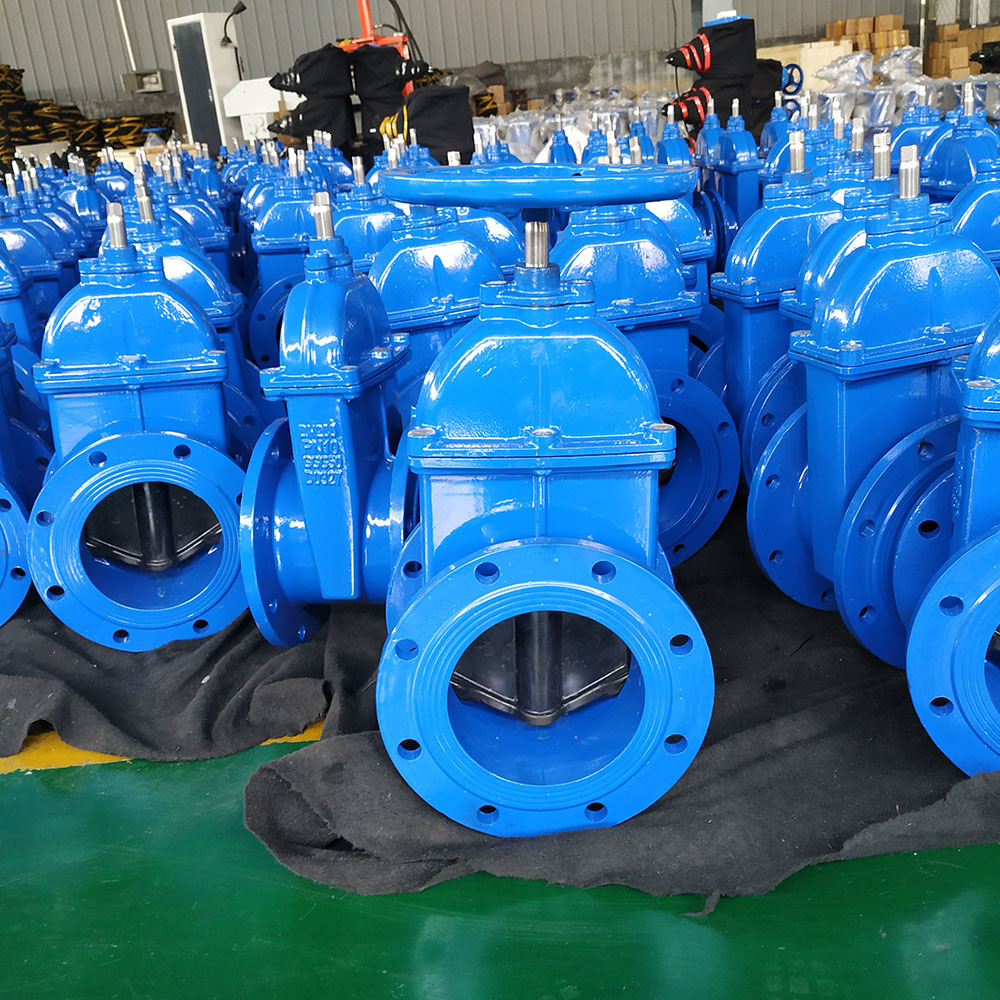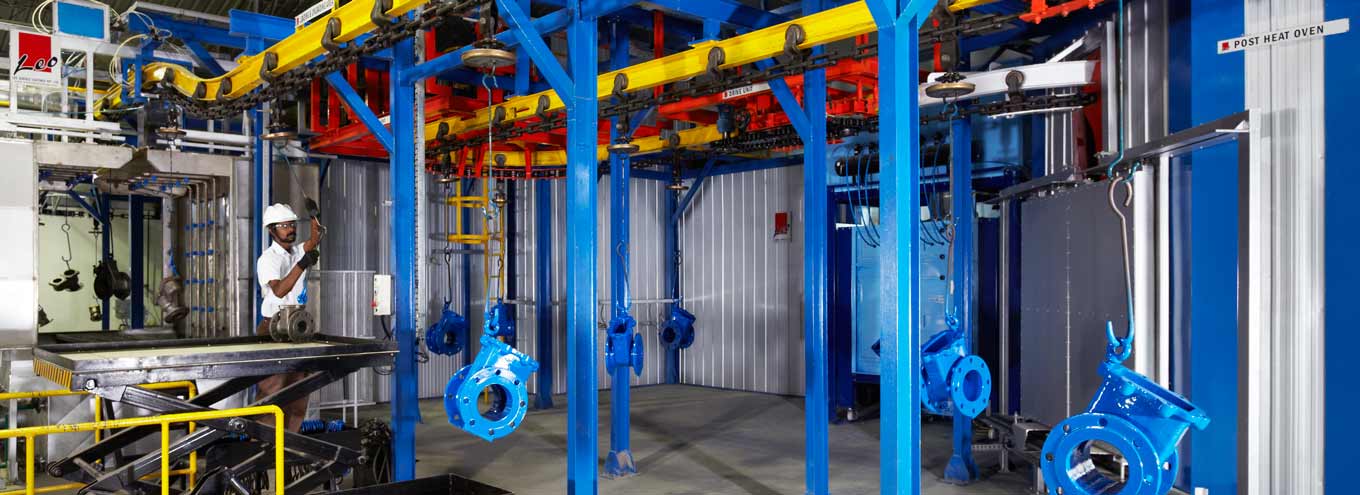


Fusion Bonded Epoxy is a one-part, heat cured, thermosetting epoxy coating that is applied as a dry powder to tile sandblasted surface of a pre-heated valve and then fused and cured in a high temperature oven. The result is a durable coating with exceptional abrasion mid chemical resistance ideally suited forvalves inwater and wastewater applications.We manufacture highly efficientFusion Bonded Epoxy Coating Plants, which meets the requirements of the customers accordingly. We ensure that latest technology is employed and are appreciated for their corrosion resistance, durability, precision designing, easy installation, optimization of energy & space, easy cleaning and cost effectiveness. These are available in various sizes. Fusion Bonded Epoxy Coating Plants made by quality approved materials that is purchase from leading vendors of the market. We also check these products on various quality parameters.


Regardless of the shape and type of surface to be coated, the FBE powder coating application has five essential stages as mentioned below:
Shot Blast cleaning is the most commonly used method for preparation of steel surfaces. This effectively removes rust, scale, slats, and makes surface rough (rough surface is called profile). Profile increases the effective surface area of the steel. The cleanliness achieved is assessed to by Swedish standard from a set of photographic slides in Swedish standard (SIS) showing examples of the common terminology of white-metal, near white-metal, etc. Typically, SA two-and-a-half is used for pipelines (equivalent to NACE N2). It is important to remove grease or oil contamination prior to blast cleaning. Solvent cleaning, burn-off, etc., are commonly used for this purpose. In the blast cleaning process, a blasting wheel uses centrifugal force to propel the abrasive against rebar in controlled direction, speed and quantity. The equipment is equipped with four blast wheels. Two blast wheels are mounted on the top of the cabinet and positioned above the pass line of the work and the other two-blast wheels are mounted in the bottom of the cabinet positioned below the pass line of the rebar.
Heating can be achieved by using several methods, but the most commonly used ones are ‘’induction heating’’& “indirect gas fired heating”. Induction heating is the process of heating an electrically conducting object (usually a metal) by electromagnetic induction, where eddy currents are generated within the metal and resistance leads to Joule heating of the metal. An induction heater (for any process) consists of an electromagnet, through which a high-frequency alternating current (AC) is passed. Heat may also be generated by magnetic hysteresis losses in materials that have significant relative permeability. The frequency of AC used depends on the object size, material type, coupling (between the work coil and the object to be heated) and the penetration depth. The material is passed through a Gallant Make Highly efficient F.B.E Heating Oven, which uniformly heats the metal part to the required FBE coating application temperature. Typical application temperature for a standalone FBE is 220 to 280C.
The FBE powder is placed on a “fluidization container”. In a fluidization container, the powder particles are suspended in a stream of air, in which the powder will “behave” like a fluid. Once the air supply is turned off, the powder will remain in its original form. The fluidized powder is sprayed onto the hot substrate using The All New I-VISTA an Elegant 100 KV Electrostatic F.B.E Powder Coating Equipment has been designed by GALLANT for Manual F.B.E Coating application. It has multiple Safety features integrated with unique & reputed bought-out item to ensure complete operator friendly & High transfer efficiency with no Back Ionization & Minimum Faraday Cage Effect. The spray gun incorporates an ionizer electrode on it, which gives the powder particles a positive electric charge.The surface to be coated is passed through the powder stream on conveyor. The charged powder particles uniformly wrap around the substrate, and melts into a liquid form. The molten powder ‘flows’ into the profile and bonds with the surface. The molten powder will become a solid coating, when the ‘gel time’ is over, which usually occurs within few seconds after coating application. The resin part of coating will undergo cross-linking, which is known as “curing” under the hot condition. Complete curing is achieved depending on the FBE coating system; full cure can be achieved in less than one minute.
The molten powder becomes a solid coating, when the ‘gel time’ is over, which usually occurs within few seconds after coating application. The resin part of coating undergoes cross linking, which is known as ‘curing’ under the hot condition. Complete curing is achieved either by the residual heat on the surface, or by the help of additional heating sources. Depending on the FBE coating system, full cure can be achieved in less than one minute to a few minutes in case of long cure FBE’s. During curing time the coating gets hardens to a solid.
Once the material has passed through the cooling tank, it is tested with a holiday detection device that electrically examines the surface for minute cracks or pinholes in the coating. If a holiday is detected, the area is marked for easy identification during the touch-up procedure. The material are conveyed from the holiday detection device to a rack area where the holidays are touched up. After the rebar are repaired, they are bundled and readied for shipment

| Color: | Blue | |
|---|---|---|
| Thickness | 10-20 mils | 1 Coat |
| Gloss at 60 deg: | 60-80 units | Din 67 530 |
| Impact Resistance | >5 Joule (44 in-lb) | Din 30 677-2 |
| Elongation: | >5% | Din 30 671 |
| Hardness: | >1,00 | Din 53 153 |
| Water Immersion: | No visible change | 90C, 672 Hours |
| Salt Spray Test: | >3000 hours | Din 53167 |
| Adhesion: | 16 Mpa (2320 psi) | 7 days, 90C EN 24 264 |